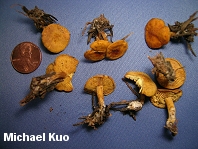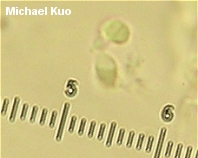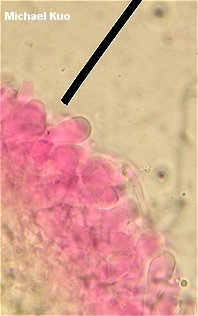| Major Groups > Gilled Mushrooms > Pale-Spored > Collybioid > Calocybe fallax |

|
[ Basidiomycota > Agaricales > Lyophyllaceae > Calocybe . . . ] Calocybe fallax by Michael Kuo, 7 November 2022 Here is a brightly colored collybioid mushroom from the northern and montane conifer forests of Europe and North America. Distinguishing features include the yellow cap, gills, and stem; the small size (caps are under 3 cm across at maturity); the white spore print; and microscopic features (see below). The European species Calocybe chrysenteron is nearly identical to the naked eye; however, under the microscope it features a pileipellis disposed as a cutis (as opposed to the hymeniform pileipellis of Calocybe fallax). It does not appear to occur in North America, despite a few herbarium records that probably represent misidentifications. There is a bona fide nomenclatural nightmare surrounding the mushroom described here; competing names for the same mushroom include Calocybe naucoria, Calocybe cerina, and Rugosomyces fallax. The nightmare extends all the way back to C. H. Peck (1873), who named the species Agaricus fallax when there was already another mushroom bearing the name Agaricus fallax (it's now called Russula fragilis, in case that matters to you), and to Singer (1943, 1962) and, more recently, to an attempt to straighten out the mess by Redhead and Singer (1978) that apparently made things worse. Oh, and the Europeans constantly argue over whether we should really use the genus name Rugosomyces instead of Calocybe. Can you tell that I don't care very much about this? If you do care, therefore, I hope you will consult a more reliable nomenclatural mess-sorter-outer than this webpage. Description: Ecology: Probably saprobic; growing alone, scattered, or gregariously in needle duff under conifers (including, in North America, grand fir, subalpine fir, balsam fir, Engelmann spruce, and lodgepole pine) or rarely in leaf litter under hardwoods (willows and alders); summer and fall; originally described from New York (Peck 1873) and central Europe (Persoon 1794); distributed in northern and montane Europe and North America. The illustrated and described collections are from Colorado. Cap: 5–30 mm across; broadly convex becoming broadly bell-shaped, flat, or shallowly depressed; soft; dry; bald; yellow to orangish yellow or brownish yellow; the margin at first somewhat inrolled. Gills: Attached to the stem, sometimes by means of a notch; crowded; pale yellow; sometimes turning brown or nearly black with age or when dried out; short-gills frequent. Stem: 2–4 cm long; 1–5 mm wide; more or less equal; dry; finely silky, or nearly bald; colored like the cap; basal mycelium whitish. Flesh: Pale yellow. Odor & Taste: Odor not distinctive; taste slightly bitter, or not distinctive. Spore Print: White. Microscopic Features: Spores 3–4 x 1–2 µm; ellipsoid; smooth; hyaline in KOH; inamyloid. Basidia 4-sterigmate. Cystidia not found. Pileipellis hymeniform/cellular; elements hyaline to yellowish in KOH; terminal cells clavate to subclavate, 15–20 x 5–7.5 µm. Clamp connections present. REFERENCES: (P. A. Saccardo, 1887) S. A. Redhead & R. Singer, 1978. (Peck, 1873; Kauffman, 1918; Smith, 1942; Singer, 1943; Singer, 1978; Moser, 1983; Brunner & Miller, 1988; Schalkwijk-Barendsen, 1991; McNeil, 2006; Hofstetter et al., 2014; Bellanger et al., 2015; Kalamees, 2018; Læssøe & Petersen, 2019; Kibby, 2020.) Herb. Kuo 08281104. Herb. DBG ROMO 2012 5026-04. This site contains no information about the edibility or toxicity of mushrooms. |
© MushroomExpert.Com |
|
Cite this page as: Kuo, M. (2022, November). Calocybe fallax. Retrieved from the MushroomExpert.Com Web site: http://www.mushroomexpert.com/calocybe_fallax.html |


